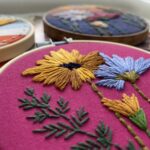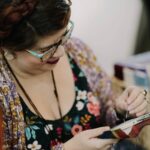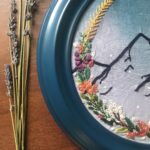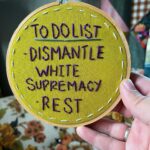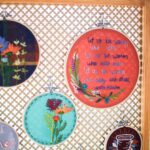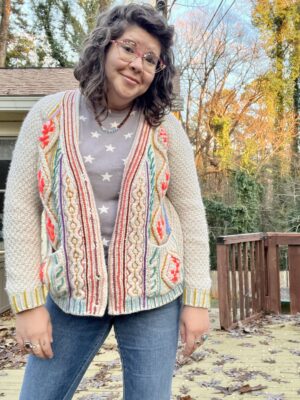
This Hispanic/Latinx Heritage Month, we are highlighting the contributions and cultural backgrounds of some of our Latinx faculty and staff. Today we highlight Sara Perez, middle school textiles teacher and member of the FSA marketing and advancement teams. This week, I sat down with Sara for an interview about her Latina identity, her thoughts on Hispanic/Latinx Heritage Month, and her role as a vendor at FSA’s upcoming celebration on October 7.
When describing her ethnic and racial identity, Sara said, “My dad is Puerto Rican so I identify as Puerto Rican. And my mom is White… I grew up just outside of LA, so there’s not a lot of Puerto Rican people in that area. It’s predominantly Mexican. And so I often felt like I wasn’t Puerto Rican enough because I grew up away from most of my Puerto Rican family… So I think growing up away from a lot of my Puerto Rican family, it was kind of hard to feel very Latin… It was hard to connect with that part…”
While she described not feeling “Puerto Rican enough” in childhood, she developed a stronger identity as a Puerto Rican woman and a person of color over time. She described this change in identity, saying: “Now I think I’ve been able to look at like past experiences and understand like where race played parts in that and like look at myself more holistically and like oh, I do identify with these cultures and these things. And I think it’s been easier to figure that out being more open with other people of color, having conversations of them not feeling represented enough, or other biracial people, trying to figure that out.”
Books also helped Sara grow more comfortable in her identity. Her favorite book that highlights Latinx voices and experiences is Wild Tongues Can’t Be Tamed: 15 Voices from the Latinx Diaspora. Sara described the impact of this book on her identity, saying, “It’s a bunch of different people’s stories about connecting to their Latinx identity and having moved from where that identity is associated with I guess and how they sort of grappled with that— like whether it was kids and like not knowing where to sit at the lunch table because they weren’t White enough, they weren’t Mexican enough. There’s not really like a Biracial table. Or really identifying with like holiday traditions but then not understanding culture as a larger sense. And I read that book recently and it really…allowed me to see myself in a different way and it felt really freeing.”
When asked what message she wants people to hear or reflect on this Hispanic/Latinx Heritage Month, Sara said, “I think it’s important to be mindful that engaging with one’s culture looks different for everyone and that sometimes people don’t engage with it because they’ve been intentionally separated, like whether that’s by their parents who were immigrants trying to assimilate or systematic oppression and things… Like, I don’t speak Spanish fluently and that’s for lots of reasons; I’m not less Latina because I don’t speak Spanish.”
Sara continued to highlight the diversity of Latinx experiences throughout the interview. She mentioned that Latinx Heritage Month can be a time for people to learn about others who are different from them and/or to learn about themselves. She said, “I think that it’s really cool that we do it [celebrate Hispanic/Latinx Heritage Month]. And as a human that grew up not quite sure where they kind of fit, I imagine that there’s lots of Latinx people who present in different ways. And so it’s nice to have that celebrated. I grew up away from a lot of my Puerto Rican family. And my grandparents—I guess it’s Puerto Rico, so it’s not really immigration—but they moved to Chicago to have better jobs and very typical immigrant story. So, I think there was a decent amount of assimilation that happened. So that month [Hispanic/Latinx Heritage Month] sort of makes me be mindful of like what is it that you can learn in that month? Or what is different? What parts of your culture can you learn about that you didn’t know?”
Sara will be participating in the FSA Hispanic/Latinx Heritage Month Celebration as a vendor, where she will sell hand embroidered items from her small business, Ra Makes (www.ramakes.com). When asked about her business, Sara said, “I am a hand embroiderer. So I have a background in fashion design and textiles. My business is called Ra Makes. Ra is a nickname for Sara…I started embroidering as a way to sort of deal with my anxiety. And now I teach other people to mindfully embroider.”
When asked if her embroidery work reflects her Puerto Rican background, Sara said, “I think there’s a certain amount of nostalgia that’s involved in it. So things that I make tend to look like maybe your grandma had made them, but then occasionally there’s like a dissenting opinion hidden in it somewhere… And the more I do it, the more I like have these childhood memories of my, we called her Little Grandma or Abuelita…embroidering and knitting. But she never spoke English, so I never really learned from her.”
We hope that you’ll join us at this year’s Hispanic/Latinx Heritage Month celebration, check out Sara’s vendor booth, and reflect on the diversity of the Hispanic and Latinx community, both within and outside of The Friends School of Atlanta. To learn more about the upcoming event, and all of the vendors involved, visit: https://friendsschoolatlanta.org/events/.
Written by Kristen Clayton.

